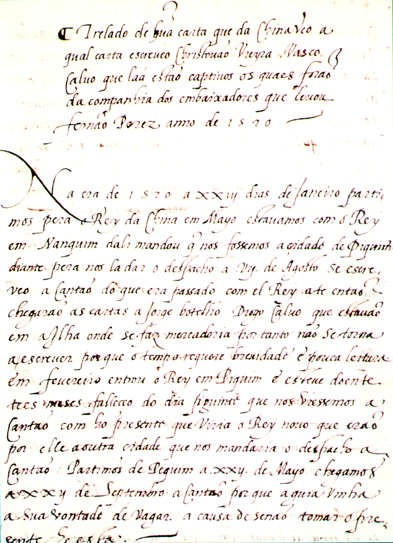[INTRODUCTION]
Cristóvão Vieira was one of the retinue with Tomé Pires, the first Portuguese ambassador to China. Nothing is known about his life before he disembarked in Guangzhou in 1517, but it is most probable that he had followed a career as a regional official for Portuguese organisations in the Far East as he already arrived vested with official duties. The famous diplomatic mission sent by King Dom Manuel I [°1469-r.1495-†1521], intended establishing a solid bases for Sino-Luso relations, which had been inaugurated a few years before. However the Portuguese ambassador did not achieve his proposals, due to a combination of unfortunate circumstances, and Tomé Pires and his aides were led back to Guangzhou for imprisonment. This happened after a short visit to Beijing at the end of 1520 or the beginning 1521, amid a climate of increasing hostility.
From 1521 onwards Cristóvão Vieira became acquainted with the darkest intrigues of the Chinese prison system for he would be transferred from prison to prison throughout many years. He was subjected to regular torture and humiliations and helplessly watching the death of his companions in jail. In 1533, when he was one of the few survivors of Tomé Pires' numerous retinue, rumours reached the prisons in Guangzhou of the return of Portuguese ships to the coast of Guangdong· province. The news was confirmed as there was even an exchange of correspondence between the unfortunate prisoners and the captain of a merchant ship which had visited an island on the Zhujian· (Pearl River) estuary that year. (See: Text 4 infra)
The ambassador's old secretary, as well as one of his companions jailed, somehow managed to receive letters from their compatriots in prison, to which they replied in long, grieving letters which still survive today. The Guangzhou captives' letters, written between 1534 and 1536, in spite of dealing with a limited experience of Chinese reality, documented interesting and unpublished information about the Middle Kingdom which up until then had been practically immune to the curiosity of Portuguese merchants and adventurers travelling around the South China Seas. Cristovão Vieira's letter, written in 1534, was especially valuable because it was written by a man who had already visited the Imperial capital and who had lived in Chinese territory for many years. The accounts taken down by Tomé Pires and Duarte Barbosa now came together in the impressions of a Portuguese view with basic knowledge of the area. Cristóvão Vieira's letter would have reached Portugal around 1538-1539, so that João de Barros could have used it in writing his Décadas da Ásia (Decades of Asia) which he was then laboriously compiling.
Thanks to the efforts of Cristóvão Vieira, China's image began to take on a more precise and detailed form, after a period of being almost totally unknown. At the same time, the more sordid aspects of Tomé Pires' mission came out in the open. With the clear intentions of conquerors, the extract included here presents China's administrative organisation and praises the riches of Guangzhou for the first time.

Tre∫lado de huã carta que da China veo a / qual carta escreueo Christouão Vieyra Vasco / Caluo que láa estão captiuos os quaes forão / da companhia dos embaixadores que leuou / Fernão Perez anno de 1520.
Copy of a letter written in Guangzhou [Canton]by Cristóvão Vieira. in 1534.
In: DESROCHES, Jean-Paul, Visiteurs de l'Empire Céleste, Paris, Musée National des Arts Asiatiques-Guimet, 1994, p.91.
* MS., Guangzhou, 1534.
start p. 43
end p.